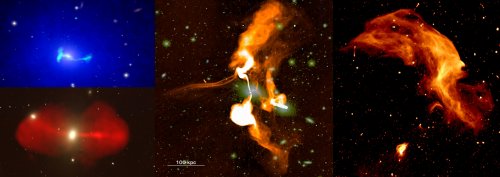A Multi-Wavelength View of Galaxy Evolution across Different Environments: from Groups to Clusters
- Data:
- Speaker: Dr. Konstantinos Kolokythas
- Affiliation: Rhodes University / SARAO (Republic of South Africa)

Much of the evolution of galaxies before they are assimilated into clusters takes place in groups where AGN feedback has the greatest impact on galaxy formation and evolution. On the other hand, clusters are the largest gravitationally bound structures in the Universe, with their baryonic mass being distributed between the constituent galaxies and the ionized plasma of their intracluster medium (ICM). As such, radio observations of galaxy clusters are powerful tools for detecting diffuse cluster-scale synchrotron emission, which carries information about the cluster formation history. In the first part of this talk, I will summarize the results from studies of the central brightest group early-type galaxies (BGEs) of an optically selected, statistically complete sample of 53 nearby groups (<80 Mpc; CLoGS sample), observed in radio 235/610 MHz (GMRT), CO (IRAM/APEX) and X-ray (Chandra and XMM-Newton) frequencies examining the jet energetics impact on the intra-group gas, the balance between hot and cold gas and the AGN activity and star formation in groups. In the second part, I will summarize the results from MeerKAT’s Galaxy Cluster Legacy Survey (MGCLS) diffuse radio emission catalogue work, a follow-up project of the first MeerKAT legacy survey paper (Knowles et al. 2022; MGCLS I) that initially was a program of long-track observations of 115 galaxy clusters at 1.28 GHz spread out over the Southern sky. I will focus on the detection rates, statistics, discoveries and properties of the various diffuse radio emission structures detected in MGCLS galaxy clusters revealing the much-improved radio images compared to previous radio observations that open up new areas of investigation in cluster formation and evolution that set the path to the SKA era.
Brief CV of Dr. Konstantinos Kolokythas:
Konstantinos Kolokythas is a Postdoctoral Research Fellow jointly at Rhodes University and SARAO (RSA) and leads the MeerKAT Galaxy Cluster Legacy Survey (MGCLS) diffuse radio emission catalogue project and the MGCLS DR2 products. He obtained his PhD in 2015 at the University of Birmingham (UK) where he studied the radio properties and evolution of nearby galaxy groups, later moving as a Postdoctoral Researcher to IUCAA (Pune, India). In 2020, he joined as an NRF Postdoctoral Fellow at North-West University in South Africa. His research focuses on both galaxy groups and clusters, particularly on the evolution of nearby galaxy groups using multi-band observations with an interest in the evolution of radio jets, their impact on the intra-group medium (AGN feedback), and the relationship between active galactic nuclei and galaxy group properties in the local Universe. In galaxy clusters, his main focus is on their evolution through diffuse radio emission observed using MeerKAT.